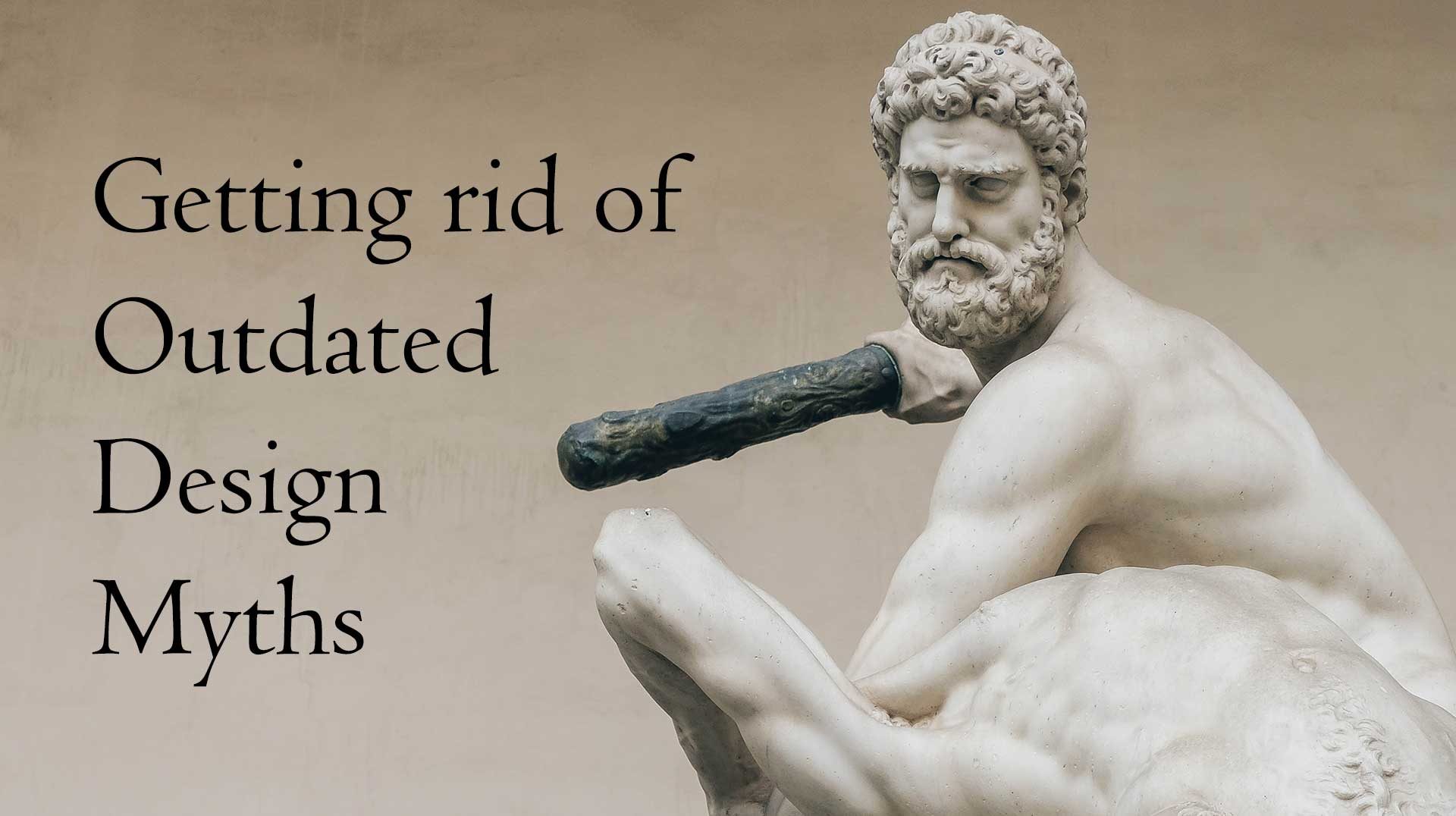Design is extremely variegated and variable. As they say – so many men, so many minds. This is why I love design as much as all other creative spheres. The process of creation itself gives inspiration and motivation to work out something, and ideas can come to mind suddenly and in many different forms.
Each person’s individual approach shapes their opinion of what good design is and how to work with it. Logically, the more opinions, the bigger the chance to be misled, and the more myths are born. Such things really may influence the person who is only getting on this rickety design ladder – and not always in a good way. Moreover, I have even seen many experienced and respected designers who, for some reason, follow design myths.
That is why we are about to do some mythbusting – and, at the same time, hope that Adam Savage and Jamie Hyneman won’t be against us stepping into their field for a bit.
Table of contents:
Myth №1: Design is art

Before you want to throw eggs in my creative self, read what I will tell you. Once, I found myself sitting at the bar and realized – my last project was a big failure. I could not understand why this happened. I went through my checklist while creating the branding for the client and did everything right. That checklist was my key to success in all previous projects. It was one of my design principles.
Suddenly, one thought came to my mind – I had too much freedom and too broadened frames drawn by my client. This was one of the projects that I had been waiting for years – the one where I could stick to myself but not to the client’s customers, sphere, etc. So, I decided to create something that I wanted to see and this should have been something no one had ever seen before. I considered it as my art.
What is art in terms of graphic design? From my subjective perspective, this is something that you create more for yourself, not for the customers and target audience. This is how YOU want to see the product design. Usually, the client’s customers see it in a different way.
Thus, we do not solve the problem, trying to express ourselves instead. This is a very wrong approach. Why does a person come to a designer? They want to find a solution. A solution that will work and help their business model. Instead of the solution, they receive some flow of creativity and a very subjective something that may not work out. Is this fair and professional in terms of your contract with a client? Wouldn’t say so.
Avoid romanticizing your job, and graphic design becomes a niche that solves certain problems within certain conditions. It is a business-oriented sphere where you need to hit the target audience by offering them a solution that they are waiting for. Not the one YOU want to see, but the one THEY need. Yep, you definitely should unleash your creative genius to some extent, but don’t overdo it and focus on purpose. If you succeed in both. Well, you are a magician!
Myth №2: Post-production can be easily built on email communication

Gosh, that’s bad. It has always been complicated to handle a big project, and – I believe you’ll agree with me on that – being snowed down under emails with iterations, broken communication, letters without any topic or sequence is a nightmare. Hell on earth unleashed. They say designers who follow design myths go there after they die, too.
If you are not the person who designs something only when your friends ask, then I do not suggest avoiding proofing or project management software. Such beauties optimize your workflow with everybody having access to the project at the same time and being able to show directly what to change. With such an aid to project communication (both internal and external), these tools are your time-money-nerves savers. Even most of the small projects require long and complicated communication that should be cut to minimum time spent but maximum productivity at the end. You cannot do it only via emails.
Myth №3: Personal Style and Personal POV are the keys

Ouch!
Let’s imagine a situation. You are a designer who quite often uses bright, lighter colors, loud phrases, and provocative designs in your works. This is your POV and something you are the best at. Many worldwide brands want you to work for them and design their identity – but not all of them are the same and have the same demands. Let’s imagine a current client who needs to design some gluten-free cereal boxes for elders. Does your usual approach solve the problem of your current customers? Not in any aspect. Even though you know your style will look awesome in that box, the target audience would not be thinking that way.
Here, we are coming back a bit to creation myth number 1. Are you working with the client to solve their problems or show your style? You were hired to make it work like a clock and hit the customer directly. In our example, 90% of the people will love what you are offering as a designer, but the 10% is the specific target audience of your client, and they do not like your design at all. You need to step into customers’ shoes and design the way they see in such situations. You need to keep targeting this 10% of people. It is your task and what you are paid for.
Myth №4: The designer is smarter than the client

A lion’s share of us would shout – HEEEEELL YEAH. But, HEEEEEELL NO!
Clients may be immensely confused while working with designers. However, you should not be surprised – many might hire a designer for the first time, and even if they don’t, they don’t and should not know much about the specifics of your work. They are hard-working and really trying to make the right decisions, but these decisions are based on their knowledge. They do not have any design degree or anything. Clients should not be blamed for sleeping design thinking, and such a situation does not make you the smartest person in the room.
I like the following phrase: “We are tourists in the client’s business.” Usually, designers work on many projects from different spheres. It helps create unique solutions but may not dive deep into the current business. Thus, you do not know the client’s business better than they are. You are both smart guys in the room who should help each other. It is a healthy relationship between you two where both should benefit. Your client helps you understand the area better and create an effective design. You help your client make the right decisions and think in the right direction. Only such a tandem may benefit you and the client’s business.
However, I should say that I am talking about knowledge only, exclusive of personality.
Myth №5: Design does not work without inspiration

Newton discovered gravitation when the apple fell on his head, but not because he was waiting for inspiration. The scientist discovered that because he asked himself why this apple had fallen. Thus, here is my point – do not wait for inspiration but ask questions.
If you have a project or some task from your client, the first thing you should do is user research. The deeper, the better. The right and suitable solution has never come to my mind while I have been sitting and waiting in my office chair. It cannot just fall from a tree, you know 🙂
Many newcomers in graphic design are too dependable on inspiration. They sit and wait while they should ask questions and gather as many details as possible. Spend one day on research, sleep on it, and think about it the next day. As the appetite comes with food, your inspiration will come when you start the work. It always happens to me and certainly helps more than waiting.
Myth №6: New/old is better

Do not try to break the user experience into some casual things. If you ask people to use a window instead of a door, they would definitely say you went bananas. Of course, if you use the window, everyone will be astonished, and the process of “walking out of the house” would be faster. But the question is whether they would be using this in their lives.
I do not mean you should not try to innovate, but some things in our lives should go with the flow. For example, if you decided to move the door handle to the bottom of the door to use your feet, it would not be a solution. Because the door handle level as it appears on the door right now is already a solution and should stay in its place. Creating new for the sake of new is just pointless.
The same goes for the old. “Ah, it used to be better back in the day!” – sounds familiar, eh? Tending to use a more old-fashioned approach just for the sake of ‘vintage’ look for whatever reason can be as harmful as pursuing something new just ‘because.’ It’s not about new or old – it’s about the purpose of the specific object. It should be useful and appealing. Most people do not need the door with the handle at the bottom or in a Victorian style – they need the door that will suit their flat design and look like it’s a great investment.
Myth №7: Designers are the customers

This one is really weird.
One of our main problems and mistakes is judging the design pattern through the prism of personal tastes. The chances are you never will be the customer of your client. For example, you are designing for some small food firm in a small town in the northernmost part of the USA. Would you ever be their customer outside the project? I doubt that.
Instead of making assumptions based on your tastes, you should better go there for the research. You need to create a solution that will judge the client’s customers who eat there every day. What is similar between you and a northern citizen of the USA? Not really much, if you’re not the one. How can you then make any assumptions sitting in the office?
Go there and feel their experience. Go through the creative process from the very beginning. Start from entering the restaurant, ordering food, and finish with leaving. Analyze it. Some details cannot be seen remotely. If you cannot order the food in the restaurant, you may miss that letters on the menu are too small and people need to squint. If the place lacks natural light or there is no good light at all, then you may not notice that the uniform pastel color is not really suitable for such conditions. Every single detail will help you later in the design process.
You should step into customers’ shoes and then make decisions. Do not judge by your taste.
A few last words
Look, I know some of the words may appear mean or very straightforward. However, this was made only for one sole purpose – you should be creating solutions by asking, researching, cooperating with the client, and stepping in the customer’s shoes. You should not follow the myths created by some prejudices or anything else. They do not allow you to fully open your potential and become a competitive player on the market. It is the only way to become a successful designer. Once you become such a professional, there would be a field for art and self-expression. Ciao!

 TEAM SOLUTIONS
TEAM SOLUTIONS WORKFLOW SOLUTIONS
WORKFLOW SOLUTIONS



 REVIEW TOOL
REVIEW TOOL PROJECT MANAGEMENT
PROJECT MANAGEMENT TOOLS & INTEGRATIONS
TOOLS & INTEGRATIONS
 CLIENT INTERVIEWS
CLIENT INTERVIEWS









